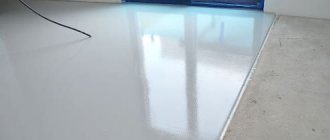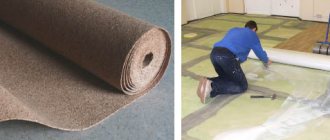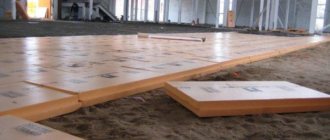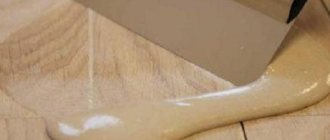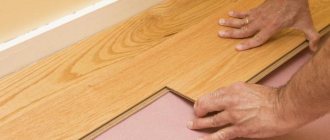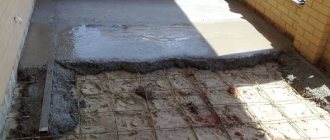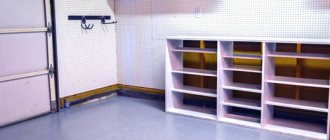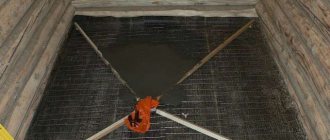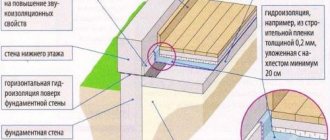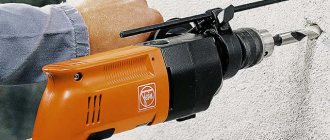2013
Concrete does not tolerate the effects of alkaline compounds, which penetrate into the porous structure and destroy it. This can be seen in the formation of dust, which leads to a narrowing of the scope of application of exposed concrete floors. To prevent this problem, concrete pavements are strengthened, thereby increasing their service life. For processing, special impregnations and dry mixtures are used.
Concrete coatings require strengthening with special compounds in order to increase their service life
Purpose
First of all, let us note the goals pursued by the concrete floor hardener:
- Increased floor strength. The pores of the structure are clogged and compacted, after which they can withstand more intense loads.
- Sealing. Impregnations and surface compounds provide adequate protection from the harmful effects of moisture and chemical elements.
- Dust removal. The salts in the coating structure bind, and the paths for the formation and removal of dust are clogged.
- Protection during curing to prevent the possibility of cracks.
Benefits of toppings
Dry concrete hardeners have a number of advantages, due to which they are widely used in modern construction.
Strength
. The use of topping increases the resistance of the concrete surface to mechanical stress, abrasion and wear by 1.5 - 3 times.
Durability
. The application of hardeners increases the wear resistance of the concrete floor and extends its service life by at least five times.
No dust formation
. Strengthened concrete becomes virtually dust-free, making cleaning much easier and extending the life of the floor.
Hygiene
. Reinforced concrete floors are easy to keep clean and cleaning the floor is not particularly difficult.
Decorative qualities
. A wide range of color hardeners allows you to make a floor of a suitable color, and the use of mixtures of different fractions can give the surface a different texture: smooth, grainy, mirror-like.
Types of hardening agents
Two methods of strengthening concrete pavement are used in construction:
- Topping.
- Impregnations.
It is worth considering each of these methods in more detail, noting their features and the types of means used.
Topping for concrete
We strengthen the concrete surface with topping using a special trowel.
This method can be compared with ironing, when fresh concrete is strengthened by grouting dry mixtures. However, the ironing method, despite the “iron” name, does not provide a very durable surface. For this reason, Portland cement with special chemical additives is used.
Based on their chemical composition, there are several types of topping:
The quartz filler is white and can be painted over with special coloring mixtures
- Quartz. Affordable and most common. The filler in them is purified fine fractions of quartz sand. Due to this, the surface also becomes decorative, especially if coloring pigments are used. This type of topping is used for floor coverings that are subject to medium loads. These include warehouses, shopping centers, medical or educational institutions. Quartz concrete hardener improves resistance to mechanical loads up to 1.5 times.
Attention! Quartz topping is also used in residential areas. In addition, it allows concrete to withstand exposure to large amounts of moisture in swimming pools, bathhouses, etc.
- Corundum. Corundum fillers are distinguished by their high resistance to abrasive influences. The use of this mineral strengthens the floor surface up to 1.6-1.8 times to mechanical loads, and increases abrasion resistance by 2 times. In terms of scope of application, corundum additives are intended for industrial premises with heavy equipment and high traffic. One can also note their decorative effect, which is accompanied by the appearance of a characteristic matte shine.
Reinforcement with metal shavings is not suitable for residential premises
- Metal. The most durable of all topping fillers. The mixture contains small metal shavings, which make the floor up to 2 times more resistant to mechanical stress. They are used exclusively for industrial premises with massive equipment and high intensity of movement of heavy equipment, as well as under other possible vibration impacts.
As you can see, the topping method is very effective. At the same time, there are funds for both residential and industrial premises. Metal topping is not used in residential construction because it unnecessarily strengthens the concrete. This increases the cost of work. In addition, hygiene and aesthetic requirements are taken into account.
Impregnations for concrete
Liquid composition for hardening
In this technology, the principle of creating a coating with a hardened top layer is completely different. In the crystal lattice of concrete there are cavities containing unbound substances or with partial connection.
Attention! If these substances in the structure of concrete are exposed to certain chemical reagents, they will acquire a connection with the crystal lattice, thereby clogging the pores and strengthening the surface.
These liquid chemicals that penetrate concrete and strengthen its structure have a special name - sealers. The concrete surface hardener in the liquid state can have a wide variety of compositions: containing mineral or organic substances.
The action occurs at the molecular level
They all act the same way: they penetrate the porous structure, fill capillaries and cracks in the concrete surface, in which all chemical fillers are neutralized. In this case, after a chemical reaction, a kind of gel is formed, which expands and fills the structure, creating a monolithic surface. This prevents the penetration of moisture into the concrete, which can lead to deterioration of strength, corrosion of the reinforcing layer, and the generation of dust due to abrasive abrasion of the surface.
As you can see, a chemical liquid concrete hardener has many advantages. They are also easy to use. For topping it is necessary to use special trowelling machines, and liquid products can be applied with a roller. In the first case, hardening is carried out on fresh concrete, and even the old layer can be restored with impregnations.
Features of using a composition containing litum in a liquid state for strengthening concrete.
Mineral hardener for concrete Topping TopHard Korund - Moscow
TopHard Corundum is a ready-to-use, colored hardener for concrete floors. Apply to freshly leveled concrete. It is manufactured using European equipment using modern recipes and contains a mixture of Portland cement, fractional corundum filler, special polymer additives and pigment. Dry hardener for the top layer of concrete (topping), consisting of alite Portland cement, fractional corundum filler, superplasticizer, special additives and pigment. Application Used to strengthen the top layer of concrete floors - increases strength by 2.7 times (bringing it to the level of M800 grade concrete). TopHard Corundum is used for both indoor and outdoor use on floors subject to medium to high traffic loads. Recommended for use in production, warehouse, retail and parking areas with high mechanical loads. It is successfully used as a replacement for expensive foreign hardeners. Result of using the material: increase in wear resistance of the floor surface by 4.5 times*; increase in the strength of the floor surface by 2.7 times*; high reflective ability; ease of cleaning; color uniformity durability and operational reliability * - compared to M300 concrete (wear resistance ~20.5cm3/50cm2, compressive strength - 29.4 MPa) Technical characteristics Hardening time: 24 hours Curing time: 28 days Light load: after 7 days Compressive strength: min. 80.5 MPa after 28 days. Flexural strength: 7 MPa after 28 days. Pull test: min. 2.5 MPa Bond strength: 1.23 MPa (100% decomposition of concrete). Wear resistance: less than 4.5 cm3/50 cm2 (0.16 g/cm2) Max grain diameter 4 mm. Application: TopHard topping is carefully scattered over the surface of the screed, trying to achieve a uniform layer thickness. Spreading is done using a special trolley for spreading topping. The consumption of TopHard topping during the first application is about 2/3 of the total consumption per 1 m2. After applying the topping, the first rough troweling is carried out using a Bartell concrete smoothing machine. Grouting must be done as soon as the topping absorbs moisture from the concrete. This will be visible by the darkening of the surface. After completing the first rough grouting, the remaining 1/3 of the topping should be immediately added so that it has time to become saturated with moisture from the laitance before the water evaporates. After the mixture is saturated with moisture, proceed to the second rough grout. The consumption of TopHard topping depends on the technical conditions and loads on the floor and is 3-5 kg/m2 (the minimum consumption for colored toppings is from 5 kg/m2) Dependence of the thickness of the topping layer on the consumption: At a consumption below 3 kg/m2 the effectiveness of application topping tends to zero, which is clearly visible in the table, because the resulting coating thickness is negligible and may disappear during grouting. At a consumption below 3 kg/m2, the efficiency of topping tends to zero, which is clearly visible in the table, because the resulting coating thickness is negligible and may disappear during grouting. Recommendations To obtain high-quality floors and eliminate surface defects, we recommend adhering to the following rules: the mobility of concrete should not be higher than P2; concrete grade – not lower than M300 (B22.5); reduce the amount of plasticizers to a minimum (if it is impossible to fulfill this point, do not exceed 5%); Avoid manual topping; exclude early or late application of topping to the surface; mandatory protection of the rubbed topping from rapid moisture loss (Ashford Formula impregnation, or TopHard Siler varnish, or polyethylene film). Packaging and shelf life Waterproof bag 25 kg 12 months. in a cool place. Production: Russia
Mineral hardener for concrete Topping TopHard Korund - sale in Moscow. From us you can purchase the product “Mineral hardener for concrete Topping TopHard Korund” at a price of 22 rubles. In order to buy this product, click on the “Show phone” button.
How to inexpensively strengthen and protect a concrete floor?
Get advice from a leading specialist +7(499) 398-02-36
Get a floor cost estimate
Don’t be afraid to do inexpensive concrete impregnation, it will meet your expectations
Dust on concrete floors is a problem faced by many owners of garages, warehouses, industrial premises, covered parking lots, etc. Excessive dust formation negatively affects the health of people in closed spaces. The impact of dust on surrounding objects is also negative. It has been noted that equipment located in such premises more often fails; in addition, it requires regular cleaning, which requires additional time and money.
What is concrete impregnation?
The concept of impregnation means a special chemical. a structure in liquid form that has the qualities of a hardener, which strengthens the upper layers of the concrete plane.
Effect of liquid hardeners, hardeners and sealants
The effect of liquid hardeners and sealants on old and new concrete surfaces is that they cause chemical reactions. This process transforms the weak and unstable calcium molecules in concrete into crystals that are indestructible and hard like granite. The metamorphosis of impregnations is based on the transformation of soluble combinations into insoluble ones. The concrete floor plane is strengthened and stability and resistance to chemically hostile areas are increased.
Their main characteristic feature is their absolute absorption into the used material and the absence of a film on the concrete. Due to this property of impregnation, it does not peel off, because there is nothing to peel off, thereby providing excellent wear resistance to the system with its absolute dust removal.
As a result of research conducted by specialists, it was found that impregnation for concrete floors guarantees the following indicators for coatings:
- improvement in wear resistance by 56%;
- immunity to the effects of chemically aggressive environments: water, oils, solvents, organic acids and alkalis;
- increase in water-repellent properties by 81%;
- complete dust removal of surfaces for a period of at least 10 years.
Therefore, in the West and gradually in our country, liquid hardening toppings are replacing dry toppings when constructing concrete floors
Most of the compositions are harmless to the human body, which allows the use of such materials for finishing floors in public and residential premises.
Features and advantages of reinforcing compounds
In addition to improving the performance properties and removing dust from the concrete floor, hardeners have a number of other advantages that are highly appreciated by modern experts.
- Decorative coatings
Impregnations for concrete make the appearance of concrete floors more attractive. With regular maintenance, the coatings acquire a light shine that remains throughout use. Anti-slip is an additional advantage of using compounds of this type. They can be made decorative by polishing, which is done by specialists after applying hardening impregnation , or by painting, which is done before using the composition. When carrying out work, it should be taken into account that such coatings cannot hide damage to the base.
- Easy and economical care
The high hardness and density of the coating does not allow dirt to penetrate deep into the concrete floor. Surfaces are cleaned using traditional cleaning and detergents, technologies and equipment. This allows you to significantly reduce the cost of operating floors, making it more accessible, efficient and of high quality.
- Maintainability
If the uncoated concrete floor is damaged in places, then it is necessary to make repairs and then carefully sand the resulting surface. Thus, the old weak layer and dirt are removed from the surface of the concrete coating, and the surface is leveled. Only after this can chemical hardeners such as LITSIL® H07, Spectrin, Monolit-20M, Linolit 25, Lithium Reflor, Lithium Hardener C2Hard, BASIC, Pentra-sil lithium, Ashford Formula be applied to the prepared coating. In cases where it is necessary to create the effect of a wet stone, experts recommend using SOFEXIL BP, hydrophobic impregnations Elcon Aqwell and Liquid Rock SH.
Characteristics of popular chemical hardeners
SOFEXIL BP (Concrete Protector) - strengthening of concrete floors based on the latest alpha-silane technology developed by the German company Wacker Chemie AG.
Strengthening with filling of pore space through the interaction of air moisture and residual moisture of concrete.
SOFEXIL BP (Concrete Protector) is a silicone product of German technology based on silane. It is used for removing dust, strengthening, increasing wear resistance and resistance to aggressive environments, all types of pollution and completely eliminates water absorption of concrete floors.
The surface exhibits high strength, excellent resistance to mechanical damage and immunity to most cleaning agents.
Wide range of applications :
- Floors subject to systematic contamination and high traffic load: garages, parking lots, logistics terminals, repair shops;
- Floors exposed to chemicals and pollutants: chemical and pharmaceutical production, oil and gas industry;
- Floors exposed to food and bacterial contamination: food industry, agricultural storage and processing facilities, silos, farms: cowsheds and chicken coops;
- Application of SOFEXIL BP for agricultural complexes;
- Floors in food courts, bars, restaurants;
- Open areas covered with concrete or concrete tiles.
Technical characteristics of the SOFEXIL BP composition:
Fireproof: flash point ISO 2719 103°C. Density at 20°C and 1013 kPa DIN 51757 1.15 g/cm3. Viscosity, dynamic at 25°C (shear rate = 5 – 400 1/S), approximate. = 75 mPa s. Appearance: transparent liquid.
Properties of a floor coated with Sofexil BP impregnation:
- Excellent adhesion to concrete floors with topping;
- Vapor permeability;
- Placed on concrete with a moisture content of 15%;
- Dust removal. Sofexil BP penetrates into the pores of concrete, and, entering into a chemical reaction with concrete, forms a hardened surface layer;
- Resistance to mechanical damage: scratch resistance, abrasion resistance;
- Dirt resistance. effective protection against all types of pollution;
- Impact resistance of the coating;
- Water resistance (hydrophobic). Water evaporates from the concrete surface, which is especially important in outdoor areas that are subject to freeze/thaw cycles.
- Oil resistance (oleophobic). Oils that fall on the floor are not absorbed and do not leave stains;
- Non-flammability;
- The floor is not slippery, because the coating does not create a film on the surface of the floor, but penetrates into the pores of the concrete;
- Strengthening the color of the coating and the possibility of tinting.
LITSIL® H07, H15, H25 - for strengthening new and old weak concrete and giving the surface a shine. This product does not contain sodium silicate or potassium silicate.
LITSIL® H25 - can be used in combination with LITSIL® S01 as a hydrophobic impregnation.
Strengthening impregnation Linolit 25 is ideal for treating freshly laid concrete, as well as old foundations whose service life does not exceed 6 months. Its purpose is to protect and remove dust from the concrete floor , making its operation longer and more comfortable. Linolit 25 increases the strength and hardness of surfaces, making them maximally suitable for finishing sanding. High performance is achieved thanks to carefully selected material components that react chemically with calcium hydroxide and make the coating more resistant to moisture absorption, mechanical stress and dust formation.
Monolit-20M
Another material widely used by specialists for strengthening concrete is Monolit-20M. It impregnates to a depth of 5-10 mm. Impregnation for concrete has unique properties. The crystals formed in the concrete make it denser, and the entire structure of the coating is cemented with a gel that has water-repellent properties. Monolith-20M is an environmentally friendly material, as it is water-based, so dust removal of concrete floors can be carried out in premises for various purposes: loading terminals, residential complexes, garages, parking lots, shops, supermarkets, etc.
Lithurin 1+2 – characteristics and features of the product
Lithurin-1 is used in combination with Lithurin-2. This material cannot be classified into any of the existing categories, so experts often classify it as a separate group of materials. Lithurin is vapor permeable. Therefore, the development of such negative processes as the formation and accumulation of condensation, which creates excessive stress and leads to breakthroughs in paint coatings, is excluded. Subsequently, the damaged areas are subject to peeling and gradual mechanical destruction.
- Lithurin-1
The action of the strengthening impregnation Lithurin-1 is based on the ability of the components of the composition to enter into a chemical reaction with the components of the concrete mixture. As a result of the so-called fluation, water-soluble magnesium and calcium salts are converted into insoluble oxides and salts. This method is one of the most affordable ways to avoid the formation of efflorescence on concrete surfaces and guarantee them increased strength.
- Lithurin-2
Hydrophobizing material Lithurin-2, used after applying the first composition, improves the decorative and water-repellent properties of the coating. This material forms a transparent film of muted olive color on the surface of the base, which enhances the aesthetics of the floor, giving it an elegant matte mirror finish. In this case, the main color of the coating remains unchanged. When working with Lithurin-2, it should be remembered that such impregnation for concrete floors is not able to hide coating defects that arise during operation or improper grinding, or even out the tone of the treated surface. After applying the composition, microcracks may form on the surface of the base. This process is natural, and the quality of the coating does not deteriorate.
In general, according to experts, the use of complex hardening impregnation Lithurin 1+2 makes it possible to increase the impact strength of the base by 4 times, guarantee 100% dust removal of the concrete floor , improve the wear resistance of the coating by 10-20 times, the resistance of the concrete base to frost and moisture, which makes the product famous manufacturer, almost perfect!
Lithurin does not contain harmful solvents. It is absolutely safe for people and the environment and is recommended for finishing food industry premises. The composition has proven its effectiveness, which has made it popular in more than 120 countries around the world.
SEAL HARD
SEAL HARD is a new generation hardening impregnation that provides floors with hardness and wear resistance under conditions of intensive use. Floors protected with this composition retain their aesthetics for a long time. They are not characterized by yellowness, which spoils the appearance of the coating, and peeling that occurs due to mechanical stress on the floor. The material is ideal for finishing coatings in garages, indoor and outdoor parking lots, as well as in workshops, since no traces of car tires remain on surfaces treated with SEAL HARD. Over time, the aesthetics of the coating improves. Treated bases acquire an attractive satin shine, which is in no way inferior to the beauty of expensive topped floors.
Water repellents : Elcon Aqwell and
BIONIC MBO2 and MBO6 - water-, oil-, and dirt-repellent impregnations with a “wet stone” effect.
Thanks to its unique composition, it can be successfully used to strengthen concrete foundations. Elcon Aqwell has high penetrating ability. Silicone impregnation for concrete improves not only the performance characteristics of the material, but also its decorative properties. Depending on the number of layers applied, the surface treated with Elcon Aqwell can acquire a discreet semi-matte or original semi-gloss shine. The coating is universal and can be used to decorate a wide variety of rooms.
BIONIC MBO2 and MBO6 based on fluorocarbonates.
Thin film coatings - an alternative or an unreasonable luxury?
Very often you can hear rave reviews about another category of materials that, according to manufacturers, are ideal for removing dust from concrete floors - epoxy or polyurethane coatings. Such compositions certainly have advantages. After processing, they create a thin protective layer on the surface of the concrete base, which is resistant to chemically aggressive environments. Polymer coatings are distinguished by high aesthetics and excellent shine; in addition, they perfectly resist the formation of stains on the surface and prevent dust.
If we talk about the disadvantages of epoxy and polyurethane films, then they include a rapid loss of aesthetics. During use, they lose their shine, scratches and chips form on them, which reduce the decorative effect of the floor. The service life of such coatings may vary. Depending on the intensity of use, on average it ranges from 2 to 5 years, which can hardly be called high. Strengthening impregnation for concrete in this matter has indicators that exceed those of polymer films several times, so such mixtures can be considered as the most suitable finishing option.
If there is minor damage, thin-film coatings can be restored. If the structural damage is too significant, the finishing must be completely replaced. Cost of 1 sq. m of coating is slightly higher than the price of treatment with impregnations for a concrete floor. Additionally, it should be taken into account that the service life of thin-film coatings is shorter, so re-application of materials may be necessary after just a few years of use. In addition, one should not forget about another feature of polymer coatings of this type, namely, the time it takes for the film to gain maximum strength. In cases where finishing of retail or production areas is necessary, every day of downtime causes loss of working time and, as a result, profit.
The modern building materials market is so diverse that sometimes even professionals find it difficult to find the best option for treating concrete surfaces. That is why you need to make a final decision only after carefully studying all proposals.
